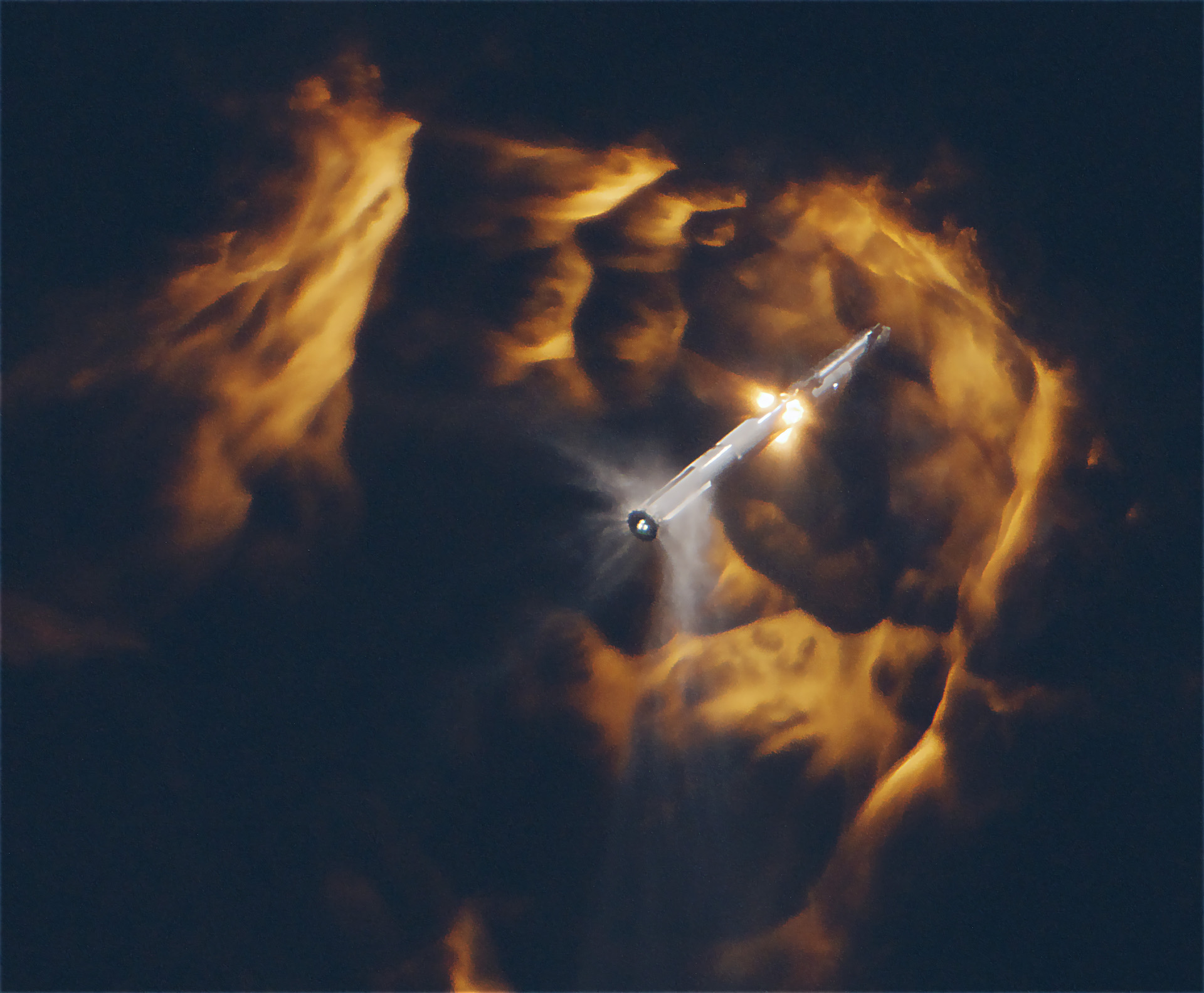The ambitious SpaceX Starship mission, designed to carry astronauts to the moon and beyond, encountered a setback as its second test, reaching 90 miles above ground, ended prematurely due to a Super Heavy rocket explosion.
Texas, NFAPost: SpaceX’s lunar exploration aspirations, the Starship spacecraft, developed for crewed missions to the moon and other celestial destinations, faced a major setback during its second test flight. Launched from the Elon Musk-owned Starbase launch site near Boca Chica, Texas, the two-stage rocketship aimed for a planned 90-minute test mission, reaching an altitude of 90 miles (148 km). However, the Super Heavy first stage booster, crucial for the mission’s success, exploded over the Gulf of Mexico shortly after separating from the core Starship stage.
This setback follows a previous attempt in April, where a similar test ended in explosive failure approximately four minutes after liftoff. The latest test aimed to address previous issues and push the boundaries of SpaceX’s Starship technology further. Despite achieving the separation manoeuvre between the Super Heavy booster and the Starship stage, the subsequent explosion and loss of contact with the vehicle raised concerns about the mission’s success.
The U.S. Federal Aviation Administration (FAA), responsible for overseeing commercial launch sites, confirmed the mishap, stating it resulted in a “loss of the vehicle.” However, no injuries or property damage were reported. The FAA will lead an investigation into the incident, and SpaceX’s plan to prevent future failures will require the agency’s approval.
The objective of the test mission was to propel the Starship into space, just shy of reaching orbit, and then guide it through Earth’s atmosphere for a controlled splashdown off the coast of Hawaii. Originally scheduled for Friday, the launch was delayed by a day for a last-minute swap of flight-control hardware.
Testing Failures and Regulatory Scrutiny
The recent failure to meet all test objectives could pose challenges for SpaceX as the FAA reviews the company’s failure investigation and assesses its application for a new launch license. SpaceX has previously expressed frustration with what it perceives as lengthy regulatory reviews, but the FAA’s involvement is crucial for ensuring safety and reliability in space missions.
Despite the setback, the failure aligns with SpaceX’s risk-tolerant culture that emphasizes rapid testing and prototyping to expedite design and engineering improvements. Carissa Christensen, CEO of space analytics firm BryceTech, noted that while some objectives were not met, the test highlighted successful aspects and introduced new capabilities.
“More things were successful than in the previous test, including some new capabilities that were significant,” Christensen said. She emphasized that considering the unique and substantial nature of the Starship vehicle, multiple tests are a reasonable part of the development process.
At an altitude of approximately 43 miles (70 km), the Super Heavy rocket executed the critical manoeuvre to separate the two stages, a milestone that wasn’t achieved in the previous test. However, moments later, the Super Heavy booster exploded, followed by the core Starship stage’s own explosion. SpaceX, acknowledging the partial success, stated on social media platform X that “success comes from what we learn” and highlighted that the core Starship stage’s engines “fired for several minutes on its way to space.”
Implications for SpaceX’s Lunar Ambitions
A fully successful test would have marked a significant step toward SpaceX’s ambitious goal of developing a versatile spacecraft capable of carrying both cargo and astronauts. The Starship program, with an estimated expenditure of $2 billion in the current year, holds strategic importance for SpaceX’s future plans. The company envisions Starship replacing the Falcon 9 rocket as the centrepiece of its launch business, extending its capabilities to missions to the moon and Mars.
NASA, SpaceX’s primary customer, has a vested interest in the success of Starship, integral to the Artemis program aimed at landing humans on the moon within the next few years. Bill Nelson, NASA chief, emphasized that the recent test failure presents an opportunity to learn and improve, reinforcing the importance of ongoing collaboration between NASA and SpaceX.
Chad Anderson, a SpaceX investor and managing partner of venture capital firm Space Capital, highlighted the urgency of SpaceX’s timeline, particularly with NASA’s objectives in mind. “The clock is ticking,” Anderson said, underlining the need for SpaceX to deliver on time, given NASA’s tight schedule for lunar exploration.
Safety Concerns and SpaceX’s Culture
While SpaceX faces scrutiny for its worker safety culture, documented in a Reuters investigation revealing hundreds of injuries at the company’s U.S. manufacturing and launch sites, the recent failure is more focused on technical and regulatory aspects. The FAA’s oversight and subsequent investigation will play a crucial role in determining the path forward for SpaceX’s Starship program.
SpaceX founder and CEO Elon Musk view Starship as a pivotal component of the company’s future endeavours in space exploration. Despite setbacks, Musk has consistently emphasized the importance of rapid testing and iteration in achieving groundbreaking advancements in space technology.
Jaret Matthews, CEO of lunar rover startup Astrolab, who has booked space on a future Starship flight, expressed confidence in SpaceX’s ability to quickly resume testing after addressing the technical challenges. However, the pace of future tests will be influenced by the FAA’s review and the extent of technical failures encountered in the recent mission.
“They have the next number of vehicles already lined up in the factory ready to go,” Matthews said. “I think people will be shocked by the cadence that emerges next year.”
In conclusion, the recent failure of SpaceX’s Starship test, while a setback, underscores the inherent challenges and risks in developing cutting-edge space technologies. As SpaceX and the FAA collaborate on the investigation and subsequent reviews, the outcome will shape the future trajectory of SpaceX’s lunar ambitions and the broader landscape of space exploration.





